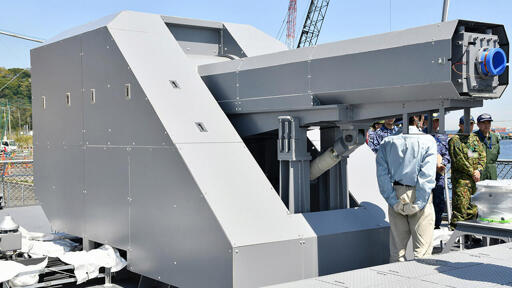Makuhari (Japan) (AFP) – As Japan’s biggest defence exhibition kicked off this week, visitors got a close-up look at a model of its futuristic “railgun” that its makers hope will be able to shoot down hypersonic missiles.
Instead of gunpowder, railgun technology uses electromagnetic energy to fire a projectile along a set of rails at ultra-high velocity.
The round will then in theory destroy the target, which could be an enemy ship, drone or incoming ballistic missile, solely with its vast kinetic energy.
Other countries, including the United States, China, France and Germany, are also developing the technology, but Japan’s navy in 2023 claimed a world first by test-firing a railgun on a ship.
“A railgun is a gun of the future that fires bullets with electrical energy, unlike conventional artillery,” an official from the Acquisition, Technology and Logistics Agency (ATLA) within Japan’s Ministry of Defence told AFP.
“It is expected that threats that can only be dealt with by railguns will emerge in the future,” said the official, who did not want to be named.
The three-day DSEI Japan Conference defence fair, which began on Wednesday, comes as Japan adopts a more assertive defence policy and looks to sell more military equipment to other countries.
In particular, Japan’s Mitsubishi Heavy Industries (MHI) and Germany’s Thyssen Krupp Marine Systems (TKMS) are competing for a major contract to supply the Australian navy with new warships.
Winning the multi-billion-dollar Project Sea 3000 contract to supply Australia with Mogami-class frigates would be Japan’s largest postwar military export order, according to Japanese media.



Like what?
Kaiju, dragons, starships, Rifts power armor, uh…space monsters/interdimensional mutants…others TBC 😅 /s
Of course Japan would defend against Kaiju.
it might be cheaper to use an electric powered weapon (like a railgun or lazer) than a chemical one (like a bomb or rocket) in some cases, like intercepting missiles
Doubtful, given that they are ridiculously expensive and can only manage a handfull of shots before the railgun rails burn out. The GAO says that military laser weapons still cost somewhere between $1 and $10 per shot, making them 2 to 20 times more expensive than regular bullets.
for the railgun the economics might not be favorable but
Bullets that can achieve the same amount of damage as the equivalent laser shot?
And then some, of course. The advantage of energy weapons is the speed of light, but they have negligible kinetic energy and zero penetration, relying on surface heating to cause damage. It typically takes them several seconds on target to knock out a drone, and even longer on missiles designed for hypersonic flight.
Once you’re talking hundreds of kilowatts of average power (usually pulsed in much shorter increments) you’re not really talking about “surface heating” but more about “metal instantly vaporizes” if you focus that beam on target.
But even then, you don’t need to hit the explosives. Pumping THAT much energy into a target will absolutely destroy sensors even if does nothing kinetic.
There are bullets and bullets. A 35mm flakpanzer round is very much not the same cost as a 9mm bullet from a random handgun.
Similarly, there are lasers and lasers. A 30kW laser like being tested in 2015 is nowhere near the 300 kW monsters like HELCAP meant for missile defence.
To compare, 300kW laser delivers 300.000 joules on target every second. Now, granted, that “target” might be a circle bigger than your actual target, but then, bullets can also miss. A 20mm solid bullet from a Phalanx CIWS delivers some 60.000 joules on target per hit. 300kW doesn’t so much “heat the missile” as it “makes metal sublimate on the spot”.
I’m sure the projectile options are greater with electric power. It doesn’t have to withstand a tiny explosion or gas pressure.